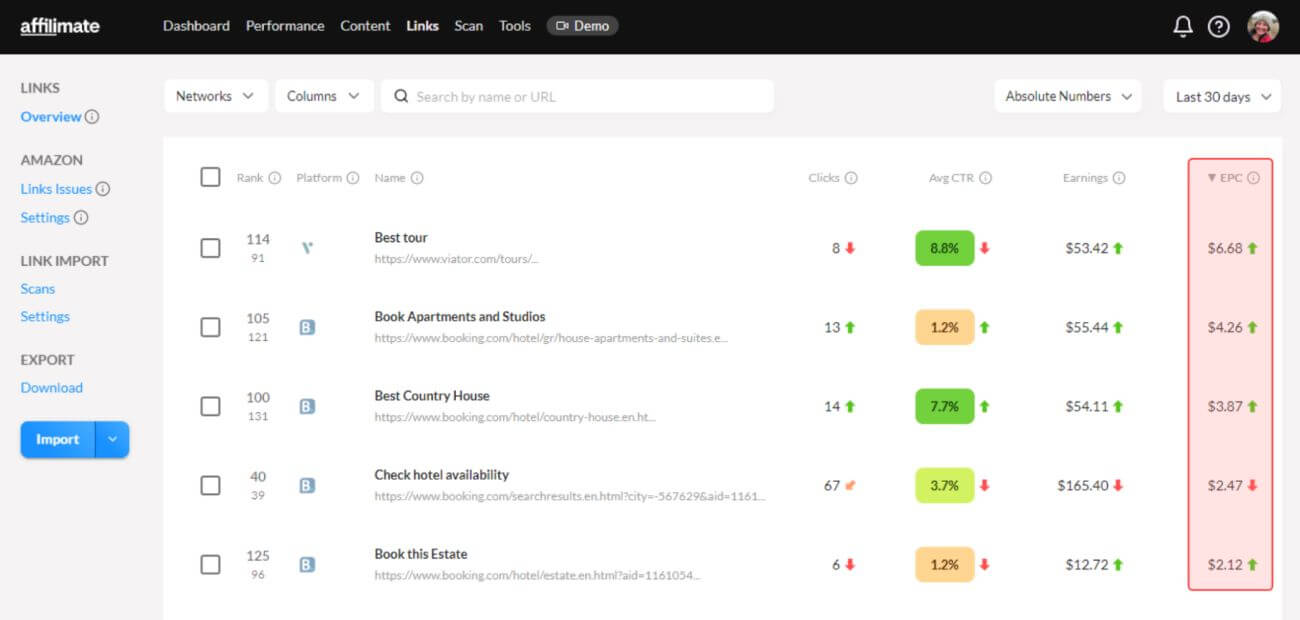Earnings Per Click (EPC): The Essential Metric in Affiliate Marketing
If you’re new to web-based affiliate marketing, you may have heard about a metric called “EPC.” So what does EPC stand for? Is EPC worth tracking? This article will explain everything you need to know about Earnings Per Click (EPC) as a digital publisher or content creator.
In simple terms, EPC refers to how much money you generate per click from an affiliate link, on average. EPC is most often tracked along with Cost Per Click (CPC), the amount spent on paid advertising to drive traffic to your affiliate offer.
But don’t be fooled: paying advertisers are not the only ones who should be tracking EPC. Earnings Per Click is an imperative metric for every affiliate marketer.
Read on to find out how we explain the EPC calculation and run down some ways to incorporate it into your content and campaign strategy.
What is Earnings Per Click (EPC) in Affiliate Marketing?
Again, Earnings Per Click (EPC) tracks the average amount of money you make on each click of your affiliate link. EPC is arguably the most important metric for affiliate marketers to track, and one you should always strive to improve.
While commission and conversion rates do play a role in affiliate marketing, EPC is the ultimate metric that can tell you how a campaign or affiliate link is performing over time.
Remember, EPC should not be confused with pay-per-click affiliate marketing, which is when an affiliate network or program pays an affiliate a very small commission for each click on their affiliate links.
While most affiliate programs require the reader to click through and purchase a product in order for the publisher to earn a commission, pay-per-click programs still pay the publisher a small commission whether the reader purchases a product or not.
Pay-per-click earnings may be included in your total Earnings Per Click, but EPC includes all affiliate earnings, such as a percentage of referred sales as well. To figure out how we can convert more of our readers into buyers, let’s drill down on Earnings Per Click.
Why is Earnings Per Click (EPC) so important?
Are you promoting an affiliate offer with a very high commission rate, but only getting low conversions? Or, vice versa, are you promoting an affiliate offer with a very high conversion rate but earning low commission rates? Both of these scenarios could lower your average Earnings Per Click.
Keep in mind, the commission rate, or flat rate, is the percentage of a sale that an affiliate network pays you after one of your readers converts into a buyer.
On the other hand, the conversion rate is the percentage of people who clicked on your link and made a purchase. While these both factor into your total affiliate earnings, you shouldn’t get caught up focusing on one or the other.
In a way, EPC is the only metric that accounts for both commission and conversion rates by calculating your average total Earnings Per Click. If you ever ask yourself “How much money am I really earning every time someone clicks this particular affiliate link?,” EPC can give you a high-level answer.
This is especially important if you are running any paid advertising in conjunction with your affiliate marketing. The most accurate way to ensure that your cost per click (CPC) advertising is paying off is to keep a close eye on your EPC as well. Of course, the goal is for costs to always be lower than earnings.
Even if you do not run paid advertising but instead rely on organic affiliate marketing strategies, Earnings Per Click is still a vital metric to track. It can help guide your content strategy by showing you what products or topics to create more content around.
If you notice a link with a particularly high EPC, that may be a great link to share across your social media channels or incorporate into your email campaigns. If you’re open to the idea of sponsorships or other types of collaboration, consider reaching out to the brands that are performing well for you.
Alternatively, you may notice a link with particularly low Earnings Per Click. You can either brainstorm ways to improve the performance of the link or let it fall to the wayside. Then, you can stop investing time and resources into promoting that particular offer.
Later on, we will explore ways to increase your potential earnings per click. Before that, let's find out the math to calculate EPC of your affiliate links.
What is the EPC calculation?
The formula to calculate EPC is rather simple: divide your total earnings from a specific affiliate link by the total clicks on that link. Be sure to always calculate your earnings data and click data based on the same time frame.
For example, let’s say you are a travel blogger and write a review of a boutique lodge you stayed at. It includes an affiliate link for your readers to book a stay there. You earn $165 in booking commissions from 67 clicks on your affiliate link in the last 30 days, which results in an EPC of $2.42.
EPC Calculation:
Total earnings / total clicks = EPC
In our example:
$165 / 67 = $2.42
The question on every affiliate marketer’s mind is: Is that a good EPC?
Annoyingly, there is no right answer to that question. The closest answer we can all agree on is that a good EPC will be higher than your EPC the month before or even the year before. If you are running paid advertising, a ‘good’ EPC will be anything greater than your cost per click (CPC).
While that $2.42 EPC is one real-life example, some publishers may see an EPC of $1 or less, and some may see significantly higher EPCs such as $8 per click or more. This varies greatly depending on your niche, the networks and programs you are a part of, as well as the products you are promoting.
The slightly more difficult part of calculating EPC is figuring out your total earnings from one specific link and how many clicks that link received. Let’s see how to determine those numbers.
How to Track Your Earnings Per Click
The easiest way to track your Earnings Per Click is to use a tool like Affilimate, which pulls the relevant data for you automatically.
Some affiliate networks track EPC for you, some don’t, and some use variations of the EPC formula. For example, instead of Earnings Per Click, they may be calculating earnings per hundred clicks.
Affilimate tracks the links from all of your networks in one place so that you can easily see the EPC for affiliate links across your website. Affilimate’s dashboard will also tell you if your EPC is trending up or down compared with past performance.
To track your Earnings Per Click, open your Affilimate Links Report and sort by EPC.

Without software dedicated to your affiliate marketing, you may have to rely on a patchwork solution of several different tools cobbling together your total earnings and total clicks per link.
In order to track how much of your earnings are being generated from an affiliate link, you’ll need to create a unique SubID or tracking parameter for that link. Most affiliate networks provide publishers with the ability to create a unique SubID when creating a link for just that purpose.
While networks like Amazon Associates track both the revenue and clicks based on the tracking ID, some networks do not track link clicks at all. In those cases, you’ll need to find another solution to track links clicks such as a plugin, like Thirsty Affiliates, or set up event tracking in Google Analytics.
Increase Your Earnings Per Click in Affiliate Marketing
As promised, here are some proven strategies for increasing Earnings Per Click in affiliate marketing. We’ll start with the best method: consistent testing and tracking.
Once you are driving consistent clicks to a particular link, consider swapping the link out with a more expensive product or a higher-paying program with a different network. Perhaps multiple vendors offer the same product at similar commission rates, but your readers may be more likely to buy from one vendor over another. Making the switch could increase your conversion rate and ultimately boost EPC.
You will also want to keep a close eye on where your traffic and conversions are coming from. For example, when an audience who trusts you receives a targeted email, they’ll likely drive significantly higher EPC than casual Pinterest browsers who click on a pin that directs to your affiliate link. Once you know which traffic sources result in the highest EPC, you’ll be able to focus your efforts on growing traffic from those sources.
The only way to know what works best for you and your audience is by testing a variety of products, vendors, and traffic sources to see what brings you the highest EPC.
Increase your revenue using the EPC metric in Affilimate
In addition to automatically tracking your Earnings Per Click, the analytics contained in Affilimate’s dashboard can help shape your plan to increase overall revenue by growing EPC.
After opening the Links Report and sorting by EPC, start analyzing your top performing links from largest to smallest. You’re looking for any patterns in the products or types of products that are performing well for you. That can tell you what items to focus on.
Click through to the Link Details to see which page or post the affiliate link is on. Here, you’re looking for patterns in the content that your affiliate links are nestled in, which will show you what kind of content to prioritize.
Now that you’ve identified some factors that may be contributing to your top performing Earnings Per Click, scroll down the Links Report to find links with lower EPC. See any links you can replace? Poor performing links may need to be updated with a top performing product, or maybe the content needs to be revised to help buyers make a decision. Learn exactly how to find buyer intent keywords for affiliate marketing here.
At a glance, the Links Report in Affilimate will show you if the EPC for a given link has increased, decreased, or remained stable over time. If you notice that a previously top performing link has suddenly dropped in EPC, that's a red flag: something may be wrong with the link or product landing page. Take a closer look at any link with decreasing Earnings Per Click to make sure it is still working and that the product is still in stock.
Conclusion
Commission and conversion rates are part of the affiliate marketing puzzle that we’re all trying to figure out, but tracking Earnings Per Click can show exactly which of your affiliate marketing efforts are paying off, and which aren’t. If you aren’t tracking EPC yet, we hope this article helps you get started.
Rather than relying on spreadsheets or trusting each individual affiliate network to report EPC on their own accord, Affilimate’s affiliate marketing software calculates EPC for you automatically. You’ll see EPC for all compatible affiliate links on your site, across multiple networks, all in one place.
Start your free trial today!

